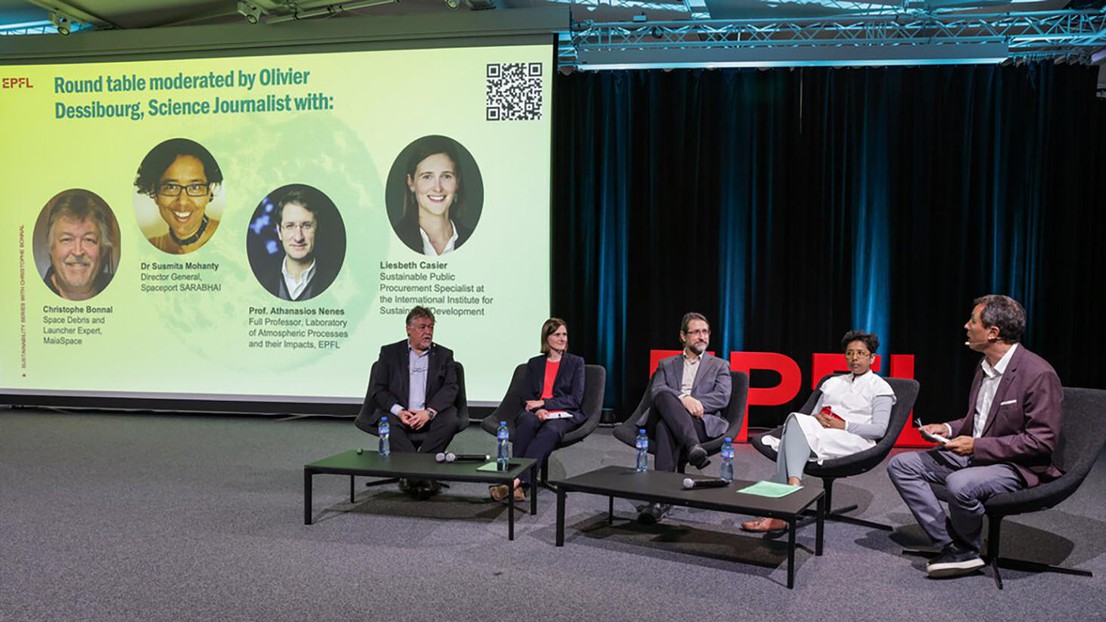A look back at the sustainability series conference with C. Bonnal

© Roundtable - 2025 EPFL/Alain Herzog
On May 27, 2025, the EPFL Rolex Learning Center hosted a thought-provoking event focused on one of the most urgent topics in the space sector today: sustainability. The conference, Towards a Sustainable Space: Addressing the Challenges of the Final Frontier, was co-organized by Mediacom and the EPFL Space Center. It took place during a landmark week for space in Switzerland, which also saw the celebration of the 50th Anniversary of the ESA Convention, the Space Community Days, and the inauguration of the European Space Deep-Tech Innovation Centre (ESDI) — marking ESA's first official presence in the country.
Setting the stage
In her opening remarks, Emmanuelle David, Executive Director of the EPFL Space Center, highlighted over a decade of EPFL’s research efforts in the field of space sustainability. She underscored the Center’s active role in advancing awareness, policy, and innovation to support a cleaner, safer orbital environment.
Re-entry and environmental footprint
Bonnal’s keynote focused on the environmental challenges posed by satellite and launcher re-entries. His presentation posed a central question: what should we prioritize to minimize impact — materials that disintegrate in the atmosphere, or those that fall intact into remote ocean areas?
Bonnal explained that anything launched into space will eventually return to Earth, particularly those in Low Earth Orbit (LEO), which re-enter the atmosphere at extremely high velocities. While many components — especially aluminum or lighter materials — burn up during re-entry, about 20% of objects survive, potentially threatening people or property on the ground. Meanwhile, the 80% that vaporize can disrupt the ozone layer and contribute to atmospheric pollution, presenting a difficult trade-off between human safety and environmental harm.
Panel discussion: sustainability across disciplines
Following the keynote, a roundtable discussion brought diverse perspectives to the table. Moderated by science journalist Olivier Dessibourg, the panel featured:
- Christophe Bonnal, Space Debris and Launcher Expert, MaiaSpace
- Dr. Susmita Mohanty, Director General, Spaceport SARABHAI
- Prof. Athanasios Nenes, Full Professor, EPFL Laboratory of Atmospheric Processes and their Impacts
- Liesbeth Casier, Lead, Public Procurement and Sustainable Infrastructure and Coordinator of the NBI Global Resource Centre at the International Institute for Sustainable Development (IISD).
The panelists explored long-term sustainability challenges, even those whose effects are not yet visible. Questions like “What will burn?” and “What will hit the ocean floor?” prompted reflection on the legal, ethical, economic, and ecological dimensions of satellite re-entry and debris management.
An engaged audience participated in the Q&A session, culminating in a closing question from Dessibourg that asked each expert to offer one actionable recommendation:
“What is one action that could be taken today by a satellite manufacturer, provider, or operator to reduce atmospheric pollution during re-entry — without compromising public safety?”
Their answers reflected both urgency and practicality:
- Bonnal: Just follow the rules, guidelines, and standards on sustainability. They exist — we need to apply them.
- Casier: Adopt a life-cycle approach to satellite design and deployment.
- Nenes: Use materials that emit fewer harmful particles during re-entry.
- Mohanty: Don’t try to take over the world — think smaller constellations.
Watch the Full Event
Missed the event or want to revisit the key moments? You can watch the full recording here.